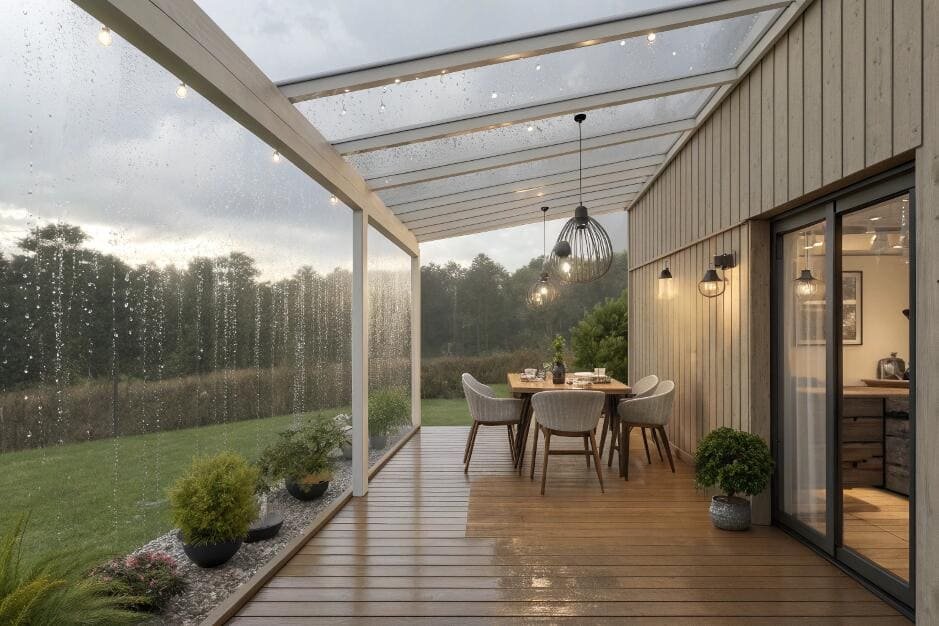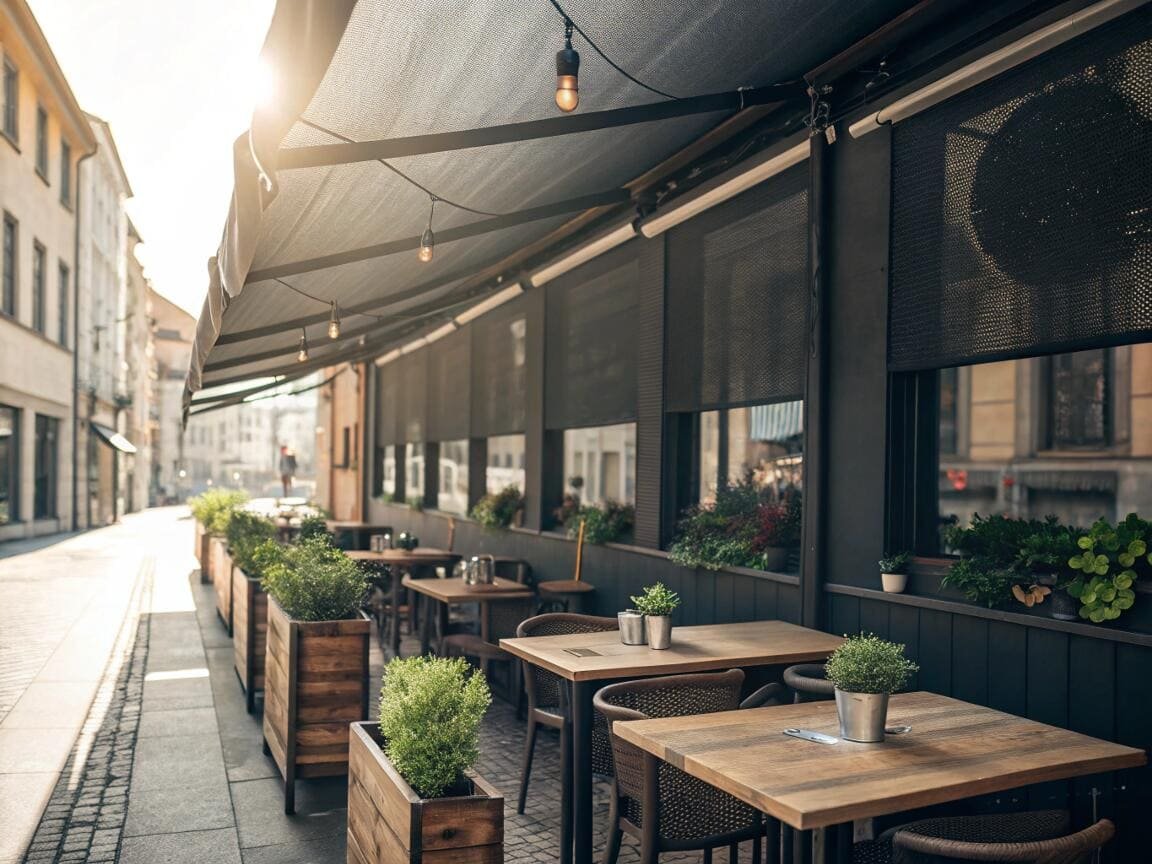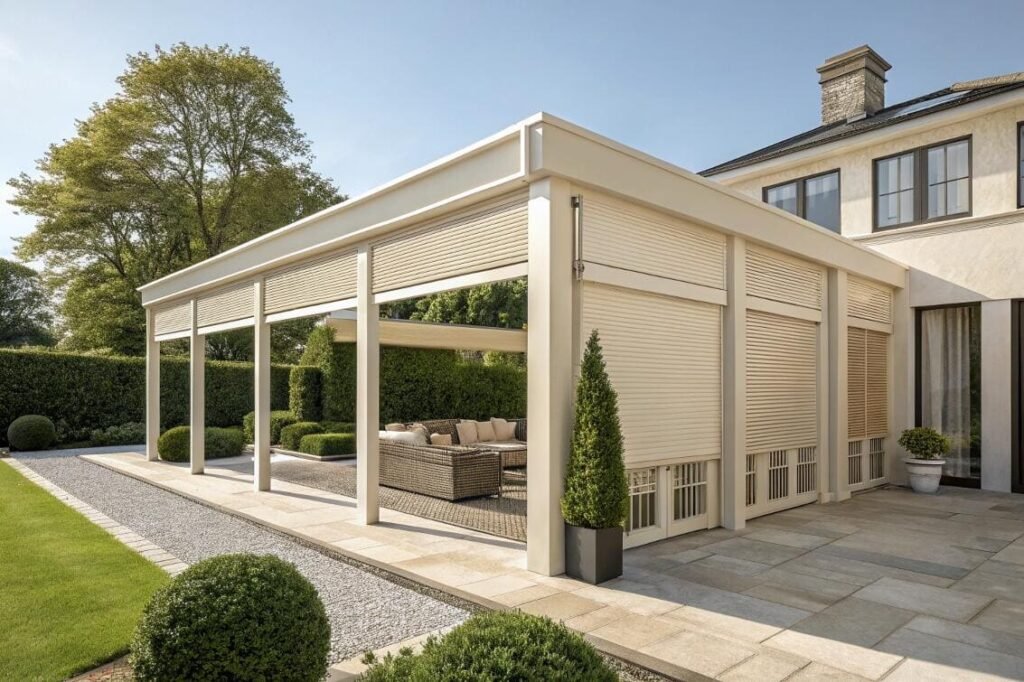Choosing the wrong material for an outdoor blind is a costly mistake. It can fade, rot, or break in a single season, leading to angry clients and damage to your reputation.
The best material depends on your primary goal. Solar mesh fabric[^1] is best for sun protection and airflow, while clear PVC vinyl is superior for blocking rain and maintaining a clear view. For ultimate durability, aluminum is an excellent choice.

As the founder of VelaBlinds, I talk to project buyers like Emma every day, and this is one of the most critical decisions we make together. The "best" material isn't a one-size-fits-all answer. It's about matching the material's properties to the specific challenges of the environment and the functional goals of the client's porch or patio. Getting this right is the foundation of a successful and long-lasting installation. Let's break down the options so you can specify with confidence.
What environmental factors determine the best material choice?
You see a great-looking blind online, but you're afraid it won't survive your local climate. How do you know if it can handle your region's intense sun, high winds, or frequent rain?
The three most important environmental factors are sun intensity (UV exposure[^2]), wind load, and rainfall frequency. Your specific climate dictates whether you should prioritize UV resistance, structural strength, or waterproofing in your material choice.

When I begin a consultation for an outdoor project, I always start with the environment. A blind that works perfectly in a calm, shaded courtyard in California might fail in a windy, coastal location in Florida. Here's what we need to consider:
- Sun & UV Exposure: If the porch is south or west-facing with no shade, it will be bombarded by UV radiation. This requires a material with high-grade UV inhibitors built in. Untreated fabrics or low-quality PVC will become brittle, discolor, and degrade very quickly. A high-performance solar mesh[^3] is engineered specifically for this.
- Wind Load: Is the location on a hill, near the coast, or in a wide-open area? Wind puts immense stress on the fabric and hardware. For windy locations, material strength is key. A durable mesh fabric or solid aluminum slats paired with a zip track or heavy-duty cable guide system is essential to prevent flapping and damage.
- Rain & Humidity: In areas with frequent rain and high humidity, the primary goal is often waterproofing and preventing mildew. This is where solid PVC vinyl excels. You also need to ensure every metal component, from the headbox to the smallest screw, is made from marine-grade stainless steel or corrosion-proof aluminum to prevent rust.
Are outdoor blinds better with PVC or Fabric?
You're stuck in a classic dilemma. Your client wants to block the sun and rain, but they don't want to lose their beautiful garden view. Which material offers the right compromise?
Neither is universally "better"; they serve different needs. PVC offers a perfect, window-like view and is 100% waterproof. Solar mesh fabric provides superior sun protection, privacy, and vital airflow for comfort.

This is the most common decision point for porch blinds, and the choice directly impacts how the space will be used. I guide my clients by asking them to pick their single most important goal. Is it to feel like you are sitting outside on a rainy day without getting wet? Or is it to have a comfortable, shady retreat on the hottest day of the year?
Material Head-to-Head: PVC vs. Solar Fabric
| Feature | Clear PVC (Vinyl) | Solar Mesh Fabric |
|---|---|---|
| Main Function | Rain Blocking & View | Sun Control & Airflow |
| View Quality | Excellent (Unobstructed) | Good (Like a screen) |
| Sun/UV Block | Low (Allows heat/glare) | Excellent (Up to 99% block) |
| Rain Protection | Excellent (Waterproof) | Fair to Good (Water-resistant) |
| Airflow | None (Sealed) | Excellent |
| Durability | Good (Can get brittle in cold) | Excellent (Very stable) |
If the project is focused on creating a "three-season room" that feels like an extension of the house, PVC is the winner. If the primary problem is a hot, unusable porch, solar mesh fabric is the only real solution.
How do different materials compare on performance and cost?
You're trying to balance the client's budget against their performance needs. You need to know the trade-offs between different materials in terms of weather resistance, durability, and overall price.
Solar mesh fabric offers the best all-around value and performance. PVC is cost-effective for rain protection. Aluminum is the most expensive but offers maximum security and durability against weather.

Understanding the cost-benefit analysis of each material is key to making a recommendation that fits the project scope. A lower upfront cost can sometimes lead to a shorter lifespan and higher replacement costs down the road.
Here’s a simplified breakdown I often share with designers:
| Material | Weather Resistance | Durability | Relative Cost |
|---|---|---|---|
| Solar Mesh Fabric | Excellent (Sun, Wind, UV) | Excellent | Mid-High |
| Clear PVC (Vinyl) | Good (Excellent for Rain) | Good | Mid |
| Aluminum | Excellent (Wind, Security) | Excellent | High |
Solar mesh is often the sweet spot. It provides fantastic protection from UV rays and heat, handles wind well in a zip track system, and has a very long lifespan. PVC is a great mid-range option if rain is the main concern. Aluminum roller shutters or blinds are a premium choice, best for ground-floor applications where security is also a factor, or in storm-prone regions where impact resistance[^4] is needed.
What is the most durable material that lasts the longest?
You need to specify a product and walk away knowing it will perform flawlessly for a decade. Callbacks for failures are not an option. You need the most robust, long-lasting solution available.
For pure longevity, premium woven solar mesh (made with fiberglass or PVC-coated polyester) and heavy-gauge, powder-coated aluminum are the most durable materials. Both can easily last over 10 years with proper system hardware.

When the primary specification is durability, we have to look beyond just the visible material. The longevity of a blind is a function of the entire system. However, the core material is the first line of defense. The most durable fabrics are typically PVC-coated polyester or fiberglass. These materials have incredible tensile strength, so they won't sag or stretch. They are also dimensionally stable, meaning they won't shrink in the cold or expand in the heat.
Similarly, the most durable hard material is aluminum. But not just any aluminum. We specify heavy-gauge slats with a thick, high-quality powder-coat finish. This finish doesn't just add color; it creates a hard shell that resists scratching, chipping, and fading from UV exposure. When you combine these premium materials with robust hardware like a Somfy motor and 316 stainless steel components, you are creating a system that is engineered to last.
How do you balance functionality with aesthetic appeal?
Your client wants high performance, but the blinds can't look clunky or industrial. They must complement the home's architecture and look great from both the inside and the outside.
Achieve balance by matching hardware colors[^5] to the home's trim and choosing a fabric that enhances the view. Dark-colored mesh fabrics often look best from the outside and preserve the best view from the inside.

An outdoor blind should feel like a planned part of the architecture, not a tacked-on afterthought. Here’s my approach to ensuring a beautiful result. First, the hardware—the cassette headbox and side channels—should be powder-coated to match the window frames or trim color of the house. This makes the system blend in and look integrated. Second, consider the fabric color carefully. From the outside, a light-colored fabric will stand out and look more opaque. A dark-colored fabric (like charcoal or black) tends to recede and look more transparent, creating a sleeker appearance. From the inside looking out, the human eye sees past the dark mesh more easily, preserving the view much better than a light-colored fabric. By choosing a dark mesh and matching hardware, you get high-performance sun protection that looks fantastic.
Conclusion
The best outdoor blind material is the one that solves your client's specific problem. By analyzing the environment and prioritizing sun, rain, or view, you can confidently select the perfect material for a beautiful, functional, and long-lasting outdoor space.
---
[^1]: Explore how solar mesh fabric provides excellent sun protection and airflow, making it ideal for outdoor spaces.
[^2]: Understand the impact of UV exposure on outdoor materials and how to choose UV-resistant options.
[^3]: Explore the features that set high-performance solar mesh apart for outdoor applications.
[^4]: Understand the significance of impact resistance in outdoor blinds, especially in storm-prone areas.
[^5]: Get tips on selecting hardware colors that complement your outdoor blinds and home architecture.Partner with VelaBlinds for Your Next Project
Smart window treatments shouldn't be complicated. After working with 500+ distributors and contractors worldwide, I've streamlined the process to get you quality products, competitive pricing, and reliable support - every time.
Why project professionals choose VelaBlinds:
- ✅ Fast, Accurate Quotes - Detailed specs and pricing within 24 hours
- ✅ Transparent Pricing - No hidden fees, volume discounts clearly outlined
- ✅ Quality Assurance - Direct partnerships with certified OEM manufacturers
- ✅ Project Support - Dedicated account manager from quote to delivery
Start your next project:
📧 Quick Quote: Send your requirements to info@velablinds.com
📱 Direct Contact: WhatsApp +86 137 2012 8317
🌐 Browse Solutions: https://velablinds.com/
📁 Product Resources: Access spec sheets, catalogs & project files
Paul Chen, Founder
"I built VelaBlinds to solve the real challenges I faced as a project buyer - long lead times, unclear specs, and unreliable suppliers. Let's discuss how we can power your projects with smarter blinds."
Serving distributors and contractors across North America, Europe, and Australia since 2018.




